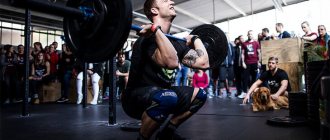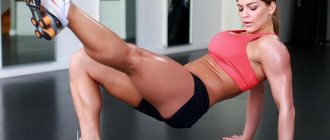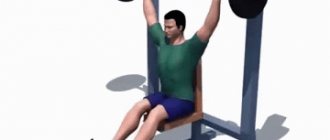Causes of edema
This inflammatory process can begin as a result of the accumulation of waste products from muscle cells. During illness, stress and other factors, protein compounds accumulate in the blood. In order to reduce their concentration in the circulatory system, the body transfers excess to muscle tissue.
When lymph does not have time to remove all protein compounds, they accumulate and take up more and more space. The cells grow and press on each other, causing muscle pain. Swelling in the muscles of the lower extremities, chest, back or arms does not go away on its own. If treatment is not started, swelling can gradually lead to serious complications:
- numbness of the limbs;
- hypertension;
- osteochondrosis;
- colitis;
- dysplasia;
- development of malignant tumors.
Causes of muscle swelling
Muscles can swell in both beginners and experienced athletes. “Edema is an external, quite noticeable swelling of tissue. Swelling occurs due to excessive accumulation of fluid in organs and extracellular tissue spaces of the body,” says Yesenia Kalyuzhina, a rehabilitation physician at the SportMedica sports medicine clinic.
Why is this happening? “There are several reasons for the occurrence: from overtraining to pathological changes,” says Ruslan Panov, expert methodologist and coordinator of X-Fit group programs in Russia . “Muscle swelling most often appears due to inadequate load, long breaks in the training process, and excessive water consumption.”
If you have “overloaded” your muscles, swelling can manifest itself in two ways. “The first is that a large amount of work and vital activity products of fiber and cells accumulate in muscle tissue, and the lymph flow cannot cope with their removal, the cell swells, and the lymphatic fluid stagnates,” explains Ruslan Panov.
The second way is the appearance of micro-tears in the muscle fiber during strength training. “The process of gaining muscle mass is directly related to microtraumas, in which fibers tear and grow together and increase in volume, which leads to inflammation and swelling, despite the fact that this is natural,” adds Ruslan Panov.
What is happening in the muscle at this moment? “Due to structural damage, an inflammatory response develops in the muscle. First, the blood vessels constrict to prevent blood loss, and then the opposite effect occurs with the goal of using chemical signals to attract immune cells from the blood vessels into the damaged muscle tissue, which causes the accumulation of fluid in the tissue,” explains Yesenia Kalyuzhina.
As a rule, intense or unusual exercise leads to muscle swelling. “One of the consequences is “delayed muscle soreness,” which results in swelling. As a rule, after 5-7 days the pain goes away. Untrained people who expose themselves to too much stress often suffer. Or athletes who use unusual types of load for themselves,” adds Yesenia Kalyuzhina.
However, if you are not generally into sports, then swelling after exercise can occur from any load in general. “If the trainee’s body is not accustomed to stress (when a sedentary lifestyle predominates, for example), then any activity can become for him the very critical intensity at which swelling occurs, either due to microtrauma or the accumulation of waste from muscle activity,” - says Ruslan Panov.
In addition, swelling of the extremities can also appear for reasons that have nothing to do with fitness. According to Yesenia Kalyuzhnaya, the reasons for this are also:
- wearing tight shoes or high heels (this interferes with the normal outflow of blood and lymph);
- sitting in an uncomfortable position (crossing your legs, you block the lymph flow);
- fatigue of the lower extremities (especially if you spent the entire day before training on your feet);
- excessive fluid intake;
- excessive consumption of salty and spicy foods;
- hot weather;
- phlebeurysm;
- injuries;
- impaired renal excretory function;
- heart failure;
- hormonal imbalances;
- obesity;
- pregnancy;
- allergy.
Muscle swelling after exercise
Inexperienced athletes sometimes wonder why muscles swell after training? The main reason is the accumulation of lymphatic fluid in the muscle tissue. This happens for the following reasons:
- high loads in the gym with a sedentary lifestyle (for example, people with sedentary work);
- starting training after removing tight shoes that impeded blood flow (for this reason, mainly the calf muscles and sometimes the thighs swell);
- the habit of sitting with your legs crossed (this leads to swelling of the leg muscles).
If muscle swelling is caused by training loads, the swelling will go away on its own within a few hours.
Possible causes of muscle swelling after exercise
Edema refers to a strong accumulation of fluid in soft tissues. If it is caused by training, then intercellular fluid is retained in the muscles and under the nearby skin.
There are two large groups of possible causes of muscle swelling:
- Various diseases
- Causes not related to disease
Let's look at each of them in more detail.
Causes not related to disease
The first and most common reason is excessive training load. Because of it, extensive microdamage to muscle tissue occurs, which leads to a large influx of lymph and blood to the affected area of the muscle.
As a result, after class they have a swollen, edematous appearance.
Usually the body copes with this problem on its own within 2-3 days. During this time interval, muscle fibers are restored and swelling goes away on its own.
The second reason is not so common among amateurs, but for professional athletes it is a standard occurrence.
We are talking about sports injuries - sprains, micro-tears of muscles, dislocations, bruises and the like. All of them are almost always accompanied by muscle swelling.
In this case, you need to contact a sports doctor as soon as possible. The sooner medical assistance is provided, the less time it will take to recover.
Another group of reasons that can cause edema are social, household and taste preferences.
People know the importance of movement, but they continue to stubbornly sit or lie down all day without even doing a basic warm-up.
Physical inactivity (sedentary lifestyle) is a 100% guarantee of swelling of the lower extremities. Since regular muscle work is necessary for normal blood circulation.
And of course, food .
Nutritional supplements that are added to our usual foods can lead to fluid retention. These include monosodium glutamate, salt, sugar, smoked, salty and spicy foods.
For example, 1 gram of sugar retains 3 grams of water.
Many “female” diets are based on knowledge of this fact. When all carbohydrates (or simple sugars) are abruptly excluded from the diet. There is a sharp loss of water and girls lose 1-2 kg per day. This option for losing weight has nothing to do with burning fat.
Add more fiber-containing foods to your diet. They will help digestion and help remove excess water.
The timing of meals is also important. The lymphatic system works more slowly in the evening, which means that the outflow of fluid is difficult during this period.
Eating dinner later than 3 hours before bedtime can also cause puffiness in the morning.
Water is also a common cause. But not its excess, as many people think, but its deficiency.
If the body does not receive enough fluid, the body retains the fluid it already has in the tissues. This is why maintaining normal water balance is so important.
The norms of water consumption per day for an adult are as follows:
- 30 ml per 1 kg body weight for maintenance
- 40 ml per 1 kg for weight loss
That is, if your weight is 70 kg, the norm would be 2.1-2.8 liters per day.
Causes associated with diseases
In medicine, there are several main causes of edema. As a rule, these are diseases of various organs and systems.
The most common diseases that lead to edema are:
- kidney
- heart and circulatory system
- gastrointestinal tract
- hyperthyroidism (thyroid disorder)
They can also be triggered by taking certain medications. For example, drugs that regulate blood pressure.
All causes are medical in nature and can only be eliminated with the help of doctors.
How to diagnose swelling?
If pain or muscle swelling occurs, it is better to go to the doctor. The specialist begins the diagnosis with examination and palpation of tissues, and the patient is also sent for an x-ray. The tumor undergoes histological examination.
An x-ray reveals solid tumors, and the doctor determines its interaction with nearby bones. Angiography provides information about the blood supply to the swollen area and clarifies the location of the lesion.
Diagnosis of edema in soft tissues sometimes requires computed tomography and magnetic resonance imaging to clarify the area of the oncological process if the tumor is malignant. These diagnostic methods also provide information about neoplasms growing deep into the internal organs.
Main symptoms and diagnosis
An elbow sprain is considered an injury and is quite common in athletes who perform activities that are not typical for the normal functioning of the elbow joint.
A sprain occurs when the physical load on a joint is many times greater than the physical capabilities of the joint. Having received such an injury, a person experiences severe pain, in addition, swelling forms and an enlargement of the elbow is observed, which, in turn, leads to impaired motor function. Also, similar injuries occur as a result of falling on the hand or as a result of blows to the elbow. The specialists of our clinic have developed a number of procedures for identifying sprained elbow ligaments, which, in principle, are based on those generally accepted in medicine, namely:
• visual examination by a doctor of the injury site. It also includes palpation with determination of temperature in the joint area and swelling;
• radiography;
• diagnostics using ultrasound;
• magnetic resonance imaging, which is a highly accurate diagnostic method with an information content of up to 99%.
What to do if your muscles are swollen and painful: treatment plan
When the muscles of the legs, arms, neck, back or other parts of the body hurt and swell, the treatment regimen is approximately the same in all cases. The doctor determines the causes of pain and the factors that provoked the disorder, and then draws up a complex of therapy.
If swelling is visible on the skin, but there is no temperature, purulent inflammation or other complications, the doctor prescribes treatment without medications:
- massage and rubbing of muscles with warming gels and ointments;
- manual therapy aimed at stimulating local blood circulation;
- physiotherapeutic procedures to relieve inflammation;
- physiotherapy;
- acupuncture.
For more serious pathologies, when pain due to muscle swelling is acute and severe, non-steroidal anti-inflammatory drugs for internal and external use are required. Sometimes doctors prescribe muscle relaxants and even psychotropic drugs. Everything is individual, so you should definitely consult a doctor.
When symptoms of a malignant tumor occur, even more complex complex therapy using serious drugs is required. Next, let's look at the reasons why muscles swell in different parts of the body.
What to do if your muscles swell after training
If the muscles swell after training not often, then everything is fine.
This is due to the increased load, to which the body responded with one of the adaptation mechanisms - the retention of intercellular fluid in the working muscles.
In a day or two this problem will go away on its own.
If your muscles swell after each workout, then it makes sense to think about using preventive measures :
- Warm up before training
It has a number of positive effects, one of which is the improvement of blood microcirculation due to the activation of the smallest blood vessels - capillaries.
The better the blood and lymph circulates, the lower the risk of swelling.
- Correct dosing of training loads
Second in order, but not in importance.
Many inexperienced athletes, having watched enough motivational videos on the Internet, try to copy the ultra-intense workouts of professional bodybuilders.
This is the most common and biggest mistake of ordinary gym goers.
They pay for it with a lack of growth in results, sore throat and regular muscle swelling after exercise.
To prevent frequent fluid retention, reduce the intensity of your training load.
Do impact training no more than once a week and only on one muscle group.
For example, in the first week you intensively pumped your chest, and the rest of the muscles in a normal or toning mode. In the second week, the legs are subjected to training shock. And so on.
Exercises in this mode are commensurate with the body’s recovery capabilities without the use of anabolic steroids.
And one of the criteria for a correctly selected load is the absence of pain and muscle swelling after training.
- Household physical activity
Remember that activity is not limited to exercise in the gym. Training takes 1-2 hours a day, and the rest of the time, movement remains the main component of human health.
Try to walk more and stretch during breaks between work.
If you can't move a lot, add more moderate-intensity cardio to your training plan. Not for the purpose of losing weight, but to maintain health.
By the way, it is cardio exercise that improves blood circulation and improves fluid outflow.
- Cool down after training
At the end of the lesson, a cool-down with stretching elements is required.
Stretching at the end of a strength training session has a beneficial effect on blood and lymph circulation, and you already know why this is good.
On rest days, you can also use various methods to speed up recovery , aimed at reducing swelling:
- Light physical activity – walking, cycling, jogging, swimming
- Bath/sauna
- Warm bath
- Massage and self-massage
- Physiotherapy
Pain and swelling of the thighs
When the muscles swell in the thigh area, this also indicates a variety of pathologies that require therapy. This happens due to a certain disorder or disease:
- getting injured while pumping the quadriceps muscle in training;
- tendon damage (this occurs more often in older people);
- problems with blood supply to the thighs;
- joint diseases.
Do not put off visiting a doctor, as swelling and pain will not disappear on their own.
Swelling of the arm muscles
The causes of pain and swelling in the arm muscles are more varied. Doctors treating such tumors attribute the following to the causes of such conditions:
- intoxication of the body;
- drug and alcohol addiction;
- stress;
- parasitic diseases;
- infectious and viral diseases;
- autoimmune disorders;
- injuries during physical activity.
For example, sepsis, streptococcus and staphylococcus, as well as bone osteomyelitis provoke purulent inflammation of the arm muscles, which causes abscesses and necrotic lesions to appear in the tissues. Treatment should not be delayed if the muscles of the upper extremities are constantly sore and swollen, as this can cause shortening and deformation of the fibers.
Preventing swelling after exercise
It is quite possible to avoid the appearance of muscle swelling if you follow the correct drinking regime, get enough sleep and get dosed physical activity. “The most important thing in preventing edema is to monitor your well-being. If the limbs are swollen or the body feels heavy, recovery operations should be performed, says Ruslan Panov. — It’s also worth starting to exercise regularly to remove excess moisture from the body, without relapses and health consequences. As soon as proper physical activity is firmly integrated into the routine of everyday life, this problem disappears and practically does not appear.”
Use these tips to avoid muscle swelling after exercise.
Tumor in the pectoral muscles
One common cause of swelling, swelling and tenderness in the pectoral muscles is myositis. The symptoms gradually increase, but it is important to prevent the disorder from worsening. In acute periods, the pain radiates to the arms and neck, and upon palpation, tension in the pectoral muscles is felt. Myositis, which causes swelling and pain in this area, can be identified by the following signs:
- pain on the surface of the chest muscles;
- swelling and swelling;
- increase in local temperature;
- feeling of pain when swallowing;
- skin redness;
- shortness of breath and cough;
- headaches.
The pecs may also swell if an athlete has pulled a muscle or suffered another injury.
Back and neck muscles
The muscles of the back, lower back and neck can swell and ache not only after training, but also for other reasons. For example, people who work outdoors all year round are at risk. Common reasons include staying in uncomfortable positions for a long time, which often happens to drivers, musicians, and massage therapists. This leads to poor circulation and poor nutrition of muscle tissue. Seals appear and dystrophy develops. Other causes of swelling in the muscles of the neck, back or lower back include:
- injuries during training (most often sprains or physical strain);
- injuries in everyday life: bruises, dislocations of the vertebrae;
- stress causing muscle spasms;
- hypothermia during physical exertion.
In the neck area, the most vulnerable muscle is the cleidomastoid muscle, which is quite easy to pull.
In rare cases, people experience pain and swelling in the muscles in their feet, shoulders, or armpits. If the problem is not intense training, that is, the swelling does not subside within a day, you need to go to see a doctor. He will determine why the muscles are swollen and prescribe the necessary treatment.
I swell after training: what to do?
Did you experience swelling after exercise? Experts recommend speeding up the process of its resorption. “It is important to pay attention in time to an increase in the volume of a limb or torso and respond correctly by taking restorative measures. Massages often help, and they vary: from restorative and relaxing to hard sports, but warming up in a sauna is not recommended, since the morphology of the process is unclear,” says Ruslan Panov.
No opportunity to visit a massage therapist? Practice myofascial release. “The essence of this effect is self-massage using hard foam rolls (you can replace them with a tightly closed bottle) and tennis balls,” explains Ruslan Panov. — The ball or roll should press the muscle in need of action to the bone. Then, in this position, you need to perform slow longitudinal or transverse rolling, adjusting the intensity by applying body weight.”
Another method to relieve swelling is kinesio taping. “This is the application of special patches with an adhesive layer that stimulate the nervous network to enhance the lymphatic drainage effect. This is the easiest way to remove excess fluid from tissue of any location (muscle swelling can appear anywhere, although large muscle groups are most susceptible: thighs, calves and ankles, back, arms),” says Ruslan Panov. It will also be useful to wear compression garments (gaiters, long sleeves) to stimulate lymph flow.
Character of tumors
Tumors that can be found on muscles are of a different nature - benign and malignant. Benign ones include leiomyoma and rhabdomyoma.
Leiomyoma is localized on smooth muscle, regardless of age. If treatment is not taken, the tumor can turn malignant. The swelling develops slowly and manifests itself as ulcers on the surface of the skin. Rhabdomyoma is localized primarily on the transversely striated muscles of the chest, back, arms and legs, as well as in the neck.
Malignant muscle tumors are dangerous, so they cannot be avoided without medical help. One of the varieties is rhabdomyosarcoma, which develops similarly to rhabdomyoma, but is of a low-quality nature. Most often, pathologies develop in the thighs and calf muscles of adults.
Less common is malignant leiomyosarcoma, which affects smooth muscle, mainly in women. Localized on the trunk and lower extremities, accompanied by ulcers on the surface of the skin. One of the most dangerous muscle tumors is osteoclastoma, which requires urgent surgical intervention.
Be attentive to your body and do not allow tumors to develop. If your muscles swell frequently, be sure to see a doctor and get a diagnostic test to avoid serious health problems in the future.











